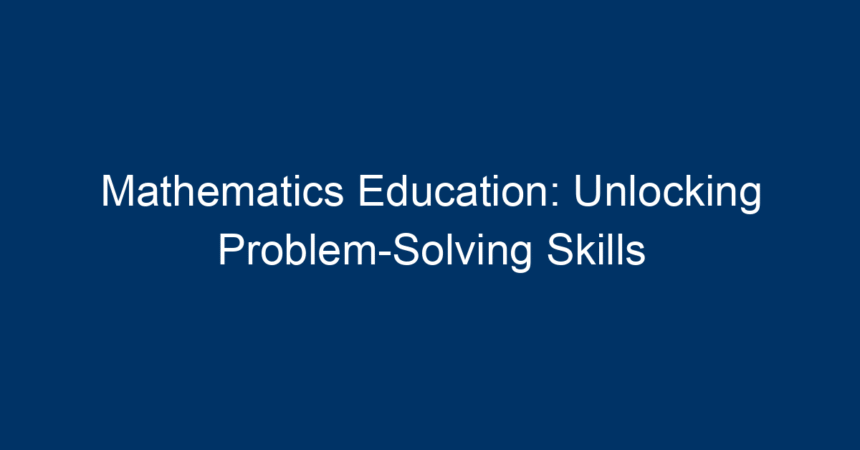Mathematics education serves as a cornerstone of overall academic development, unlocking problem-solving skills that are imperative for personal and professional success. In a world increasingly driven by data and analytical thinking, mastering mathematics is not just beneficial; it’s essential. This article delves into the importance of mathematics education, its role in enhancing problem-solving skills, and ways to make math more accessible and engaging for students.
The Importance of Mathematics Education
A Foundation for Critical Thinking
Mathematics education goes beyond rote memorization and calculations; it cultivates critical thinking skills. By engaging with mathematical concepts, students learn to analyze situations, evaluate information, and approach problems logically. This foundational training in reasoning is valuable not only in math-related fields but across all disciplines.
Real-World Application
From budgeting personal finances to understanding statistical data in news articles, the applications of mathematics are everywhere. When students see the relevance of math in everyday life, they become more motivated to learn. Mathematics education equips students with the tools they need to make informed decisions, thereby improving their quality of life.
Preparing for the Workforce
In today’s competitive job market, employers increasingly demand problem-solving skills, analytical thinking, and scientific reasoning. Careers in STEM (Science, Technology, Engineering, and Mathematics) fields rely heavily on these capabilities. Robust mathematics education can significantly enhance employability, making it a vital component of a well-rounded curriculum.
Problem-Solving in Mathematics Education
Understanding the Problem
Effective problem-solving begins with understanding the problem at hand. This phase requires students to identify what is being asked and the information available. For instance, when dealing with word problems, students must break down the information into manageable parts. This analytical approach fosters a deeper comprehension of mathematical concepts.
Techniques for Teaching Problem Identification
- Guided Discussion: Encourage group discussions around various problems to lead students through recognizing key elements.
- Visual Aids: Use diagrams and charts to help students visualize problems, improving understanding and recall.
Developing a Strategy
Once students grasp the problem, they must choose an appropriate strategy to tackle it. This may involve applying learned formulas, using trial and error, or even collaborating with peers. Mathematics education should encourage students to explore multiple methods for solving a single problem, fostering creativity and adaptability.
Recommended Strategies
- Modeling: Use real-life scenarios to demonstrate how math can solve everyday problems.
- Algebraic Thinking: Teach students to represent problems algebraically for greater flexibility in solving them.
Implementing the Solution
The crucial phase of problem-solving is the implementation of the chosen strategy. Here, students apply mathematical operations to arrive at a solution. This step reinforces the importance of accuracy and precision in mathematics education.
Practical Exercises
- Step-by-Step Challenges: Present students with multi-step problems, allowing them to practice their implementation skills systematically.
- Peer Teaching: Encourage students to explain their solutions to classmates, reinforcing their understanding.
Evaluating the Solution
Post-implementation, students should evaluate their findings. This stage not only reinforces their learning but helps them understand the significance of reflection in problem-solving. Mathematics education should emphasize the importance of checking work and considering whether the solution makes sense in the context of the problem.
Techniques for Evaluation
- Self-Assessment Tools: Provide checklists for students to use when reviewing their work.
- Discussion Groups: Create a space where students can discuss their solutions and learn from each other’s approaches.
Engaging Students in Mathematics Education
Making Math Fun
Bringing an element of fun into mathematics education can help alleviate the anxiety many students feel about the subject. Interactive activities, games, and technology can create an engaging environment that promotes love for learning.
Tools and Resources
- Math Games: Incorporate board games, card games, and online platforms to make learning a playful experience.
- Educational Software: Utilize math-focused apps that encourage interactive problem-solving.
Providing Real-World Context
Linking mathematical concepts to real-world problems can make the content more relatable and inspiring. Real-world applications can motivate students to engage more deeply with material as they see its value outside the classroom.
Examples of Real-World Connections
- Financial Literacy: Teach students about budgeting, loans, and investments through practical examples.
- Data Analysis: Introduce statistical concepts using current events, enabling students to analyze trends and make predictions.
The Role of Technology in Mathematics Education
Introduction to EdTech
Educational technology can significantly enhance mathematics education and problem-solving skills. With myriad resources available, incorporating technology into teaching can provide diverse approaches to learning.
Innovative Tools
- Interactive Simulations: Websites and software that allow students to visualize and manipulate mathematical concepts.
- Online Collaborations: Virtual classrooms where students can work together to solve problems across geographical boundaries.
Future Trends in Mathematics Education
The role of artificial intelligence (AI) and machine learning is expanding in education. These innovations can tailor learning experiences to fit individual student needs, making mathematics education more personalized and effective.
Actionable Insights for Educators
- Encourage Collaboration: Foster group projects and discussions to allow students to learn from one another.
- Utilize Real-World Problems: Integrate examples from various fields to highlight the relevance of mathematics.
- Embrace Technology: Leverage educational technology to create interactive and engaging learning experiences.
- Focus on Conceptual Understanding: Prioritize teaching methods that emphasize understanding over memorization to cultivate deeper knowledge.
Conclusion
Mathematics education is a vital element in unlocking essential problem-solving skills that students will carry with them throughout their lives. By integrating effective teaching strategies, making math engaging, and utilizing technology, we can foster a generation of critical thinkers and adept problem solvers. The future of mathematics lies in its ability to adapt to students’ needs, ensuring that everyone can appreciate its value and utility. By taking actionable steps in mathematics education today, we can prepare students not just for exams, but for life.




